
The Schempp-Hirth Discus is a Standard Class glider designed by Schempp-Hirth. It was produced in Germany between 1984 and 1995 but has continued in production in the Czech Republic. It replaced the Standard Cirrus. It was designed by Klaus Holighaus.
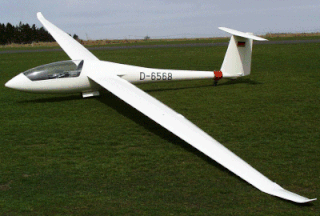
The Schempp-Hirth Ventus is a sailplane produced during 1980–1994 by Schempp-Hirth, a German sailplane manufacturer. It was designed by Klaus Holighaus and replaced the Schempp-Hirth Mini-Nimbus. Schempp-Hirth manufactured 613 Ventus sailplanes.

The Schempp-Hirth Mini Nimbus is a 15 Metre-class glider designed and built by Schempp-Hirth GmbH in the late 1970s.
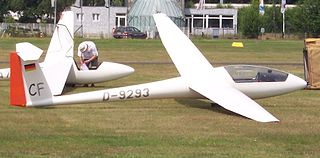
The Rolladen-Schneider LS1 is a Standard Class single-seat glider manufactured in Germany by Rolladen-Schneider from 1968 to 1977.

The Standard Cirrus is a German Standard-class glider built by Schempp-Hirth. The Standard Cirrus was produced between 1969 and 1985, when it was replaced by the Discus. Over 800 examples were built, making it one of the most successful early fibreglass glider designs.
The Schempp-Hirth HS-3 Nimbus was a prototype glider built by Klaus Holighaus.

The Schempp-Hirth Nimbus-2 is an Open Class glider built by Schempp-Hirth during the 1970s. The Nimbus-2 first flew in April 1971 and a total of over 240 examples of all subtypes have been built until the beginning of the 1980s. It replaced the Schempp-Hirth Cirrus.
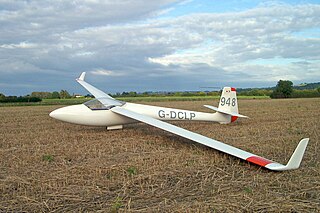
The Glasflügel 201 Standard Libelle is an early composite Standard Class single-seat sailplane produced by Glasflügel from 1967.
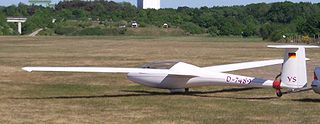
The Glasflügel 303 Mosquito is a composite 15 metre Class single-seat sailplane manufactured by Glasflügel between 1976 and 1980.

The ASW 19 is a single-seat glider built by Alexander Schleicher GmbH & Co, first flying in 1975. It was originally designed as a Standard Class glider, but now mainly competes in the Club Class. The ASW 19 is known for its pleasant handling and some clubs use it as a training glider. It was succeeded by the all-new Schleicher ASW 24.

The G102 Astir is a single seat glassfibre Club Class sailplane, designed by Burkhart Grob and built by Grob Aircraft. It was the first Grob-designed sailplane, with the first flight in December 1974. Grob had previously built the Schempp-Hirth Standard Cirrus under licence.

The Glasflügel 206 Hornet is a Standard Class sailplane produced in Germany between 1975 and 1979. Of conventional sailplane design with a T-tail, it replaced the Standard Libelle, featuring composite construction throughout. Differences from the earlier aircraft included a redesigned canopy, retractable monowheel landing gear, and provision for 100 kg (220 lbs) of water ballast.

The SZD-59 Acro is a single-seat glass composite glider for aerobatics and cross-country flying by PZL Allstar of Bielsko-Biala, Poland.

The Glasflügel 604 is a high-wing, T-tailed, single seat, FAI Open Class glider that was designed and produced in West Germany by Glasflügel starting in 1970.
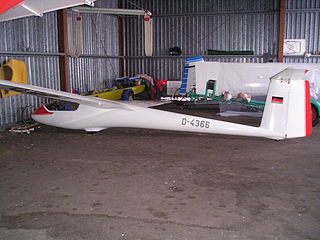
The Bölkow Phoebus is a glass fibre composite competition sailplane, designed and produced in Germany in the 1960s. Large numbers were built, achieving success at some national contests, and many remain active.

The Standard Austria was a single-seat aerobatic glider that was originally designed and built in Austria from 1959 but production was moved in 1962 to Schempp-Hirth in Germany.

The Schempp-Hirth SHK Open Class glider was developed in Germany by Schempp-Hirth. It was based on the 1964 version of the Standard Austria, known as the SH. The Austria was originally a single-seat aerobatic glider that had been designed and built in Austria from 1959 but production was moved in 1962 to the Schempp-Hirth factory in Germany.

The SZD-41 Jantar Standard was a Standard Class glider designed and produced in Poland from 1973.
The Applebay GA-111 Mescalero is an American high-wing, T-tailed single-seat, FAI Open Class glider that was designed by George Applebay.
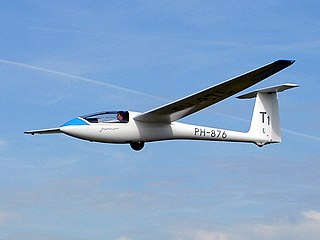
The PZL Bielsko SZD-51 Junior is a Polish single-seat training and club sailplane.



















